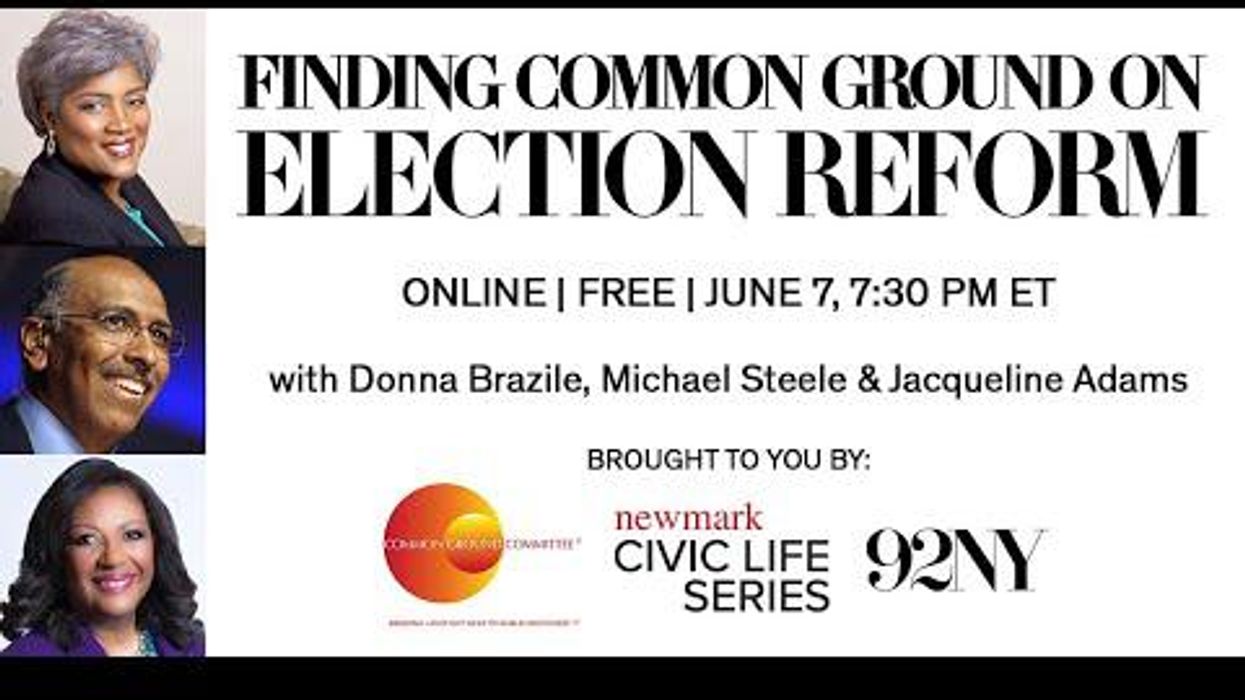Four years ago, Michael Steele and Donna Brazile sat down together in Charlottesville, Va., to discuss ways a Republican and a Democrat can bridge the divide on issues of race, despite their partisan differences.
Steele, a former chairman of the Republican National Committee, and Brazile, who led the Democratic National Committee, reconvened Tuesday to find common ground on election reform.
Early on, Steele framed the discussion around three words.
“The three words are ‘we the people,’ and the fundamental principle is that all of us get to play,” Steele said. “It may not have started out that way. But that's how it is right now. And the fact of the matter is, if we don't embrace that from the beginning ... it doesn't matter.”
Both forums were, appropriately enough, sponsored by the Common Ground Committee, which hosts solutions-oriented events to bridge the partisan divide.
Before getting to reform ideas, the pair discussed the state of democracy in the United States.
“This is a system that has been weakened, and it's being drained of trust,” Brazile said. “And if we don't take prudent steps to revitalize our democracy, I think we're in trouble.”
While the upcoming midterm elections will likely feature Republicans hammering Democrats on rising inflation and gas prices, according to Steele, if voting rights legislation goes by the wayside, other issues become less important.
“The reality of it is — those things don't matter if you can't vote,” Steele said. “The fundamental aspect for me is, how do we re-engage with each other to be stewards of our civic responsibility ... to make certain that everyone has free and unfettered access to a ballot box, and that our government doesn’t get in the way of that?”
The moderator, former CBS correspondent Jackie Adams, introduced a 2006 clip of Republican Sen. Mitch McConnell, now the minority leader, supporting the body’s decision to vote 98-0 to reauthorize the 1965 Voting Rights Act, which prohibited racial discrimination in voting.
Despite McConnell’s willingness to reinforce safeguards against racial discrimination in 2006, Adams said, the senator now says the John Lewis Voting Rights Advancement Act, passed by the House of Representatives in 2021 to reinforce provisions of the VRA that were struck down by a 2013 Supreme Court decision, is unnecessary.
Steele said the only thing that’s changed in those 16 years is the position of the Republican Party.
“The reality of it is he was right in 2006. He's dead wrong now. He knows it. Everyone knows it,” he said.
But, Steele said, there’s no active spirit within the Republican Party to enter that space and fight for change. It’s incumbent on voters to make that change through the ballot box, he argued.
After Brazile said some legislation is still actively creating obstacles to voting for Black and poor people, Adams asked if Republicans were guilty of systemic racism by preventing the loss of power by the traditional white ruling class through a lack of voting reform.
“Absolutely,” Steele said.
He pointed to the “Southern strategy” — a political realignment of voters by the Republican Party in the 1950s and 1960s, amidst the Jim Crow era and the civil rights movement, to maximize their support among white voters — alongside voter suppression tactics in the 21st century.
Brazile said it’s difficult to hold on to “American” values of access and fairness because elections are decentralized, meaning the rules are set by local and state governments. Federal reforms, such as the For the People Act, the John Lewis bill and the Freedom to Vote Act, have all been blocked by Senate filibusters.
“As long as you need 60 votes, you won't be able to fix anything,” Brazile said. “It's not going to come simply because our lawmakers are trying to make it happen.”
The discussion of state-level laws quickly turned to partisan gerrymandering, which, according to Brazile, ignores the presence of non-aligned voters for much of the process. Because independent voters don’t have a say in primaries, they spend much of the time on the sidelines, she said.
Steele said the issue boils down to elected officials deciding where their districts are and how the power is distributed.
The conversation turned to Georgia, where recently enacted laws were expected to tamp down voter turnout. Instead, large numbers of voters took part in the recent primaries.
“‘Just because people can swim doesn't neglect the fact that there's still sharks in the water,’” she said, channeling voting rights advocate Stacey Abrams. “When the rules have changed, you go out and you educate people, you provide them with information.”































